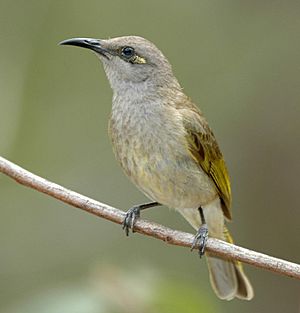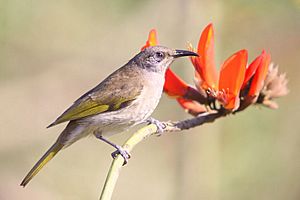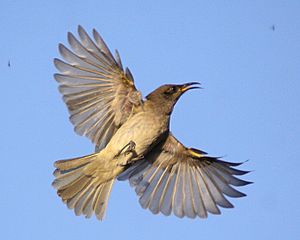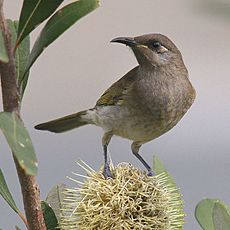Brown honeyeater facts for kids
Quick facts for kids Brown honeyeater |
|
|---|---|
 |
|
| Conservation status | |
| Scientific classification | |
| Synonyms | |
|
The brown honeyeater (Lichmera indistincta) is a type of honeyeater bird. These birds are mostly found in Australia and New Guinea. They have special tongues that look like brushes, which help them drink nectar from flowers.
This bird is medium-small and brownish. It has yellow-olive colors on its tail and wings. You might also spot a small yellow patch behind its eye.
Brown honeyeaters live in many places across Australia. They can be found from mangroves to eucalypt woodlands. They move around during different seasons to find flowering plants. While they often feed alone, they can also join small groups. Sometimes, they even feed with other types of honeyeaters. They eat nectar and insects.
Brown honeyeaters usually nest in the same area each year. They lay two or three eggs in a cup-shaped nest. Both the male and female birds help build the nest and feed their young. This bird has a loud, clear, and musical song. Many people say it's the best song among all honeyeaters!
Even though their numbers are going down in some areas, like the Wheatbelt in Western Australia, the brown honeyeater is not in danger overall. The IUCN says it is of least concern for conservation.
| Top - 0-9 A B C D E F G H I J K L M N O P Q R S T U V W X Y Z |
About the Brown Honeyeater's Name
The brown honeyeater was first described in 1827. Two scientists, Nicholas Aylward Vigors and Thomas Horsfield, gave it the name Meliphaga indistincta. The word indistincta comes from Latin and means 'unclear' or 'hard to see'. This was because the bird they studied was in poor condition.
Later, the bird was placed in a different group called Gliciphila. Today, it is known as Lichmera indistincta. The name Lichmera comes from a Greek word meaning 'to lick' or 'to dart the tongue'. This describes how the bird uses its tongue to get nectar.
There are also different types, or subspecies, of the brown honeyeater. These include ocularis, melvillensis, limbatus, and nupta. For example, melvillensis is named after Melville Island, where it lives. Some experts think the Indonesian honeyeater (Lichmera limbata) is actually a subspecies of the brown honeyeater. Recent studies show they are very closely related.
Scientists have also found that honeyeaters are related to other bird families. These include pardalotes, Australian warblers, and fairy-wrens. They all belong to a larger group called Meliphagoidea.
What Does the Brown Honeyeater Look Like?
Size and Colors

The brown honeyeater is a medium-small bird. It is about 12–16 centimetres (4.7–6.3 in) long. Its wingspan is about 18–23 centimetres (7.1–9.1 in). On average, it weighs about 9–11 grams (0.32–0.39 oz).
Both male and female birds look very similar. The female is just a little smaller. Their head, back, and upper tail are brown. Their wings are a darker brown. The only special marks are a small yellow patch behind the eye and dull yellow-olive colors on their folded wings and tail. The yellow patch can be hard to see on some birds.
Young birds look like the females. However, they might not have the yellow tuft behind their eye, or it might be very faint.
Beak and Eyes
The brown honeyeater has a black bill. It is long, thin, and curves slightly downwards. This shape is perfect for reaching deep into flowers. The inside of the male's mouth is black when it's breeding. At other times, it's pale yellow. The female's mouth is always pale yellow. Young birds have a bright yellow and swollen mouth. Their eyes are brown, and their legs and feet are grey-black.
Amazing Songs of the Brown Honeyeater
Even though the brown honeyeater looks quite plain, its song is truly special. People often describe it with very strong words. One study called it "A glorious voice, easily the best songster among Australian honeyeaters." Another report said, "As a singer it has no superior among the honeyeater family."
It has a clear, rolling, and musical call. It sounds like sweet-sweet-quarty-quarty. This song is very loud for such a small bird! Both male and female birds sing. They usually sing early in the morning. During breeding season, the male sings throughout the day. If there's danger, they make a harsh ke-ke alarm call several times.
Where Brown Honeyeaters Live and Their Homes
Wide Range of Habitats
The brown honeyeater lives in many different wooded areas. It is found all over Australia. The main type of brown honeyeater lives from Newcastle in New South Wales, north and west to Queensland, and across to Western Australia. It is not often seen in Sydney anymore. It is rare in South Australia and not found in Victoria or Tasmania.
Other types of brown honeyeaters live in New Guinea, the Torres Strait Islands, and Cape York. Some are found on the Tiwi Islands, Bali, and the Lesser Sundas. Others live on the Aru Islands.
Moving for Food
Brown honeyeaters move around in their local area depending on where flowering plants are. For example, more birds appear in Toowoomba in southeast Queensland during winter. In the Northern Territory, they stay in a smaller area during the dry season.
They are often found in coastal mangrove areas. They also live in woodlands near mangroves, like those with Banksia, Melaleuca, or Callistemon trees. They are common in sclerophyll forests and eucalypt woodlands. In dry parts of Australia, they are often found near water sources. They visit flowering shrubs in parks and gardens too.
How Brown Honeyeaters Behave
Brown honeyeaters are busy and active birds. They fly around a lot, hovering over flowers and chasing insects in the air.
What They Eat
Brown honeyeaters mostly feed in the leaves and flowers of trees and shrubs. They also look for food on the ground. They usually feed alone or in pairs. However, they sometimes join small groups or mixed flocks with other honeyeaters. These can include banded, yellow-tinted, and rufous-throated honeyeaters.
They mainly eat nectar from flowers. They also catch insects. Some of their favorite nectar sources are flowering mistletoe, mangroves, bloodwood, woollybutt, cajeput, and Banksia and Grevillea species. They get nectar from flowers that have cup-shaped parts, brush-like flowers, or tube-shaped flowers. They might hover over small flowers or perch on a stem for larger ones.
They catch insects from leaves or bark. Sometimes they fly out to catch insects in the air. They eat beetles, flies, ants, wasps, and bees.
Brown honeyeaters are most active in the early morning. This is when flowers have the most nectar. Their body weight goes down overnight, then increases during the day as they eat. They make up about half of the water they lose overnight during their first hour of feeding. They can usually get enough energy from nectar. In winter, they need to be careful about which plants they visit to get enough energy. If nectar is less concentrated, they just feed more often.
How They Raise Their Young
Male brown honeyeaters sing more to attract a mate. Pairs usually nest alone, especially where there are not many birds. In one area, nests were at least 20 metres (66 ft) apart. They use the same nesting areas every year. However, we don't know if the same birds use them each year.
The breeding season changes a lot depending on the location. Brown honeyeaters can breed at any time of the year. They might breed two or more times a year if conditions are good. The nest is built in different types of plants. It's usually in thick leaves, in the fork of a horizontal branch. Nests are often near water and rarely more than 2 metres (6.6 ft) above the ground.
The nest is a small, deep, round cup. It is made from small pieces of grass and soft bark, especially Melaleuca bark. They use spider web to hold it together. The inside is lined with soft plant fluff, like from Banksias, or with animal hair. Both male and female birds help build the nest. The male also guards the female while she is building.
The eggs are usually rounded ovals. They are white and not shiny. Sometimes they have a pink or brownish color. They can be plain or have faint reddish or brownish spots. The eggs are about 17 millimetres (0.67 in) long and 13 millimetres (0.51 in) wide. A clutch usually has two or three eggs.
The female bird sits on the eggs to keep them warm. She also keeps the chicks warm after they hatch. Both parents feed the young birds and clean the nest. The young birds leave the nest after about thirteen or fourteen days. About 44% of nests successfully raise young birds.
Some nests are attacked by green tree ants, which hurt the baby birds. Pied currawongs also take young birds from nests. Other birds, like the brush cuckoo and pallid cuckoo, sometimes lay their eggs in brown honeyeater nests.
Is the Brown Honeyeater Safe?
The number of brown honeyeaters is going down in the Wheatbelt region of Western Australia. This is because their natural homes are being cleared. However, their numbers are growing in cities, parks, and gardens. But in these new places, more birds are dying from cats, cars, and hitting windows.
Overall, there are still many brown honeyeaters, and they are found in many places. Because of this, the IUCN says the brown honeyeater is of least concern for conservation. This means it is not currently in danger.
See also
 In Spanish: Mielero pardo para niños
In Spanish: Mielero pardo para niños




